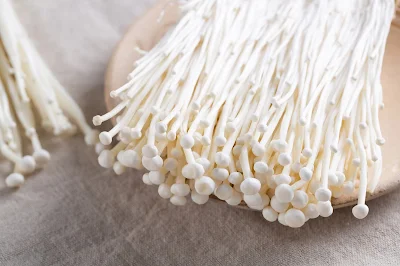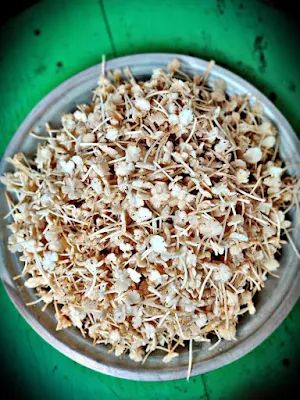Enoki Mushroom Recipe | Enoki Mushroom Taste | Enoki Mushroom Recipe Indian Style
Enoki Mushroom Recipe.
- Here at A Biobritte Agro, we’re unabashed mushroom lovers. So we were thrilled to get our hands on some Enoki mushrooms!
- This type of mushroom is common in Japanese and Chinese cuisine, but it only recently started to be easy to find at non-specialty American grocery stores.
- The enoki mushroom is incredibly delicious and absolutely worth experimenting with within the kitchen!
- Sauté up a bunch, or add them to a bowl of ramen or hot pot. Here’s a bit more about why you should grab some enoki mushrooms when you see them!
What’s an enoki mushroom?
- You may have seen enoki mushrooms in photographs of ramen or hot pot: it looks like long, white noodles. Here’s what you need to know about this variety
- The enoki mushroom is an edible mushroom that looks like long strings; almost like noodles!
- Enoki mushrooms are common in Japanese cuisine, where they’re known as enokitake, and Chinese cuisine where they’re known as golden needles or lily mushrooms.
 |
| Enoki Mushroom |
What does an enoki mushroom taste like?
- This mushroom has a delicate, savory flavor and a crunch from the thin strands.
- You can eat it sauteed or raw in salads, or throw it raw into ramen and hot pot and it cooks up right in the broth.
How to store and clean them
- Once you get your enoki mushrooms, what’s the best way to keep them fresh? And how to clean them before cooking them?
- Store the mushrooms in a paper bag in the refrigerator (not the produce drawer).
- The best way to store mushrooms is in a paper bag, which allows them to breathe. Leave them in the main part of the refrigerator to get good airflow, not the produce drawer.
- Clean them with a quick rinse. Give the mushrooms a quick rinse to get off any dirt (don’t soak them or they can become soggy).
 |
| Enoki Mushroom Cleaning |
How to cook this enoki mushroom recipe
Ready to get cooking?
Try this Sauteed Enoki Mushroom recipe!
- It makes a pan of ultra-savory, umami-packed mushrooms that are absolutely irresistible. In fact, I couldn’t stop eating them.
- After Alex took these photos, I kept sneaking back to the pan and ended up eating them all before he could dig in.
- Even better, this delicate type of mushroom takes only 2 minutes to cook! Here’s what you’ll do (or skip to the recipe below):
- Slice off the root at the bottom of the bunch. You’ll notice the enoki mushrooms are connected into a bunch with a bottom root. Cut that off before you use them!
- Cook 1 minute over medium heat. We like using sesame oil for sautéing here: the standard kind, not toasted (which is used in small quantities for adding flavor).
- Add garlic and cook 30 seconds, then add soy sauce. This type of mushroom is so delicate, it’s almost done! Just another 30 seconds and it’s done. Add tamari or soy sauce, and they’re ready to eat!
- Eat these enoki mushrooms as a side dish, with a stir fry, or throw them into noodles like sesame soba noodles. Keep reading for other ways to serve them.
 |
| Enoki Mushroom |
More ways to serve enoki mushrooms
Don’t want to make sauteed enoki mushrooms?
There are lots of other ideas where you don’t even need to cook them separately.
Here’s what to do:
Ramen: Throw into ramen broth in the last few minutes of cooking. Try Easy Vegetarian Ramen, Vegan Mushroom Ramen, Tofu Ramen, or Miso Ramen.
This enoki mushroom recipe is vegetarian, vegan, plant-based, dairy-free, and gluten-free.
Ingredients
8 ounces enoki mushrooms (about 2 bunches)
2 tablespoons sesame oil (standard, not toasted)
2 medium garlic cloves
1 tablespoon tamari or soy sauce
For the garnish: thinly sliced chives or green onion tops
Instructions
- Remove the lower root end of the enoki stems. Wash the mushrooms and pat them dry. Mince the garlic.
- Heat the sesame oil over medium-high heat. Add the mushrooms and saute for 1 minute.
- Add the garlic and cook until softened and fragrant, about 30 seconds. Stir in the soy sauce and remove from the heat.
- Serve immediately as a side garnished with sliced chives or green onion tops, or with soba noodles.
 |
| Enoki Mushroom Recipe |
Where to find it?
You can find this type of mushroom at some grocery stores, health food stores, or Asian grocery stores. You can also find it at farmer’s markets.
Tags- spicy enoki mushroom recipe, japanese enoki mushroom recipe, spicy enoki mushroom recipe korean, enoki mushroom recipe stir fry, enoki mushroom recipe indian style, what is enoki mushroom, enoki mushroom recipe samgyupsal, enoki mushroom recipe vegan, enoki mushroom poisoning, enoki mushroom online, enoki mushroom price india, enoki mushroom near me, enoki mushroom price in mumbai, enoki mushroom online india, enoki mushroom price per kg in india,

Comments
Post a Comment